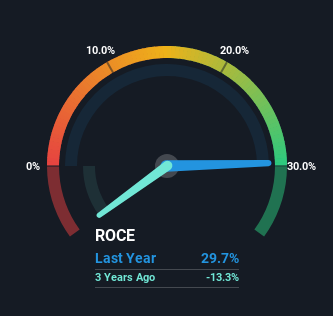Investors Should Be Encouraged By Qantas Airways' (ASX:QAN) Returns On Capital

If you're not sure where to start when looking for the next multi-bagger, there are a few key trends you should keep an eye out for. Firstly, we'd want to identify a growing return on capital employed (ROCE) and then alongside that, an ever-increasing base of capital employed. Basically this means that a company has profitable initiatives that it can continue to reinvest in, which is a trait of a compounding machine. And in light of that, the trends we're seeing at Qantas Airways' (ASX:QAN) look very promising so lets take a look.
Understanding Return On Capital Employed (ROCE)
For those that aren't sure what ROCE is, it measures the amount of pre-tax profits a company can generate from the capital employed in its business. To calculate this metric for Qantas Airways, this is the formula:
Return on Capital Employed = Earnings Before Interest and Tax (EBIT) ÷ (Total Assets - Current Liabilities)
0.30 = AU$2.5b ÷ (AU$19b - AU$11b) (Based on the trailing twelve months to December 2023).
Therefore, Qantas Airways has an ROCE of 30%. In absolute terms that's a great return and it's even better than the Airlines industry average of 8.7%.
See our latest analysis for Qantas Airways

Above you can see how the current ROCE for Qantas Airways compares to its prior returns on capital, but there's only so much you can tell from the past. If you'd like to see what analysts are forecasting going forward, you should check out our free analyst report for Qantas Airways .
What Does the ROCE Trend For Qantas Airways Tell Us?
We're pretty happy with how the ROCE has been trending at Qantas Airways. The figures show that over the last five years, returns on capital have grown by 139%. The company is now earning AU$0.3 per dollar of capital employed. Interestingly, the business may be becoming more efficient because it's applying 22% less capital than it was five years ago. A business that's shrinking its asset base like this isn't usually typical of a soon to be multi-bagger company.
For the record though, there was a noticeable increase in the company's current liabilities over the period, so we would attribute some of the ROCE growth to that. Effectively this means that suppliers or short-term creditors are now funding 57% of the business, which is more than it was five years ago. And with current liabilities at those levels, that's pretty high.
The Bottom Line
From what we've seen above, Qantas Airways has managed to increase it's returns on capital all the while reducing it's capital base. Investors may not be impressed by the favorable underlying trends yet because over the last five years the stock has only returned 16% to shareholders. So exploring more about this stock could uncover a good opportunity, if the valuation and other metrics stack up.
If you want to know some of the risks facing Qantas Airways we've found 2 warning signs (1 is a bit unpleasant!) that you should be aware of before investing here.
If you'd like to see other companies earning high returns, check out our free list of companies earning high returns with solid balance sheets here.
Valuation is complex, but we're here to simplify it.
Discover if Qantas Airways might be undervalued or overvalued with our detailed analysis, featuring fair value estimates, potential risks, dividends, insider trades, and its financial condition.
Access Free AnalysisHave feedback on this article? Concerned about the content? Get in touch with us directly. Alternatively, email editorial-team (at) simplywallst.com.
This article by Simply Wall St is general in nature. We provide commentary based on historical data and analyst forecasts only using an unbiased methodology and our articles are not intended to be financial advice. It does not constitute a recommendation to buy or sell any stock, and does not take account of your objectives, or your financial situation. We aim to bring you long-term focused analysis driven by fundamental data. Note that our analysis may not factor in the latest price-sensitive company announcements or qualitative material. Simply Wall St has no position in any stocks mentioned.
About ASX:QAN
Qantas Airways
Provides air transportation services in Australia and internationally.
Low and slightly overvalued.
Similar Companies
Market Insights
Community Narratives




